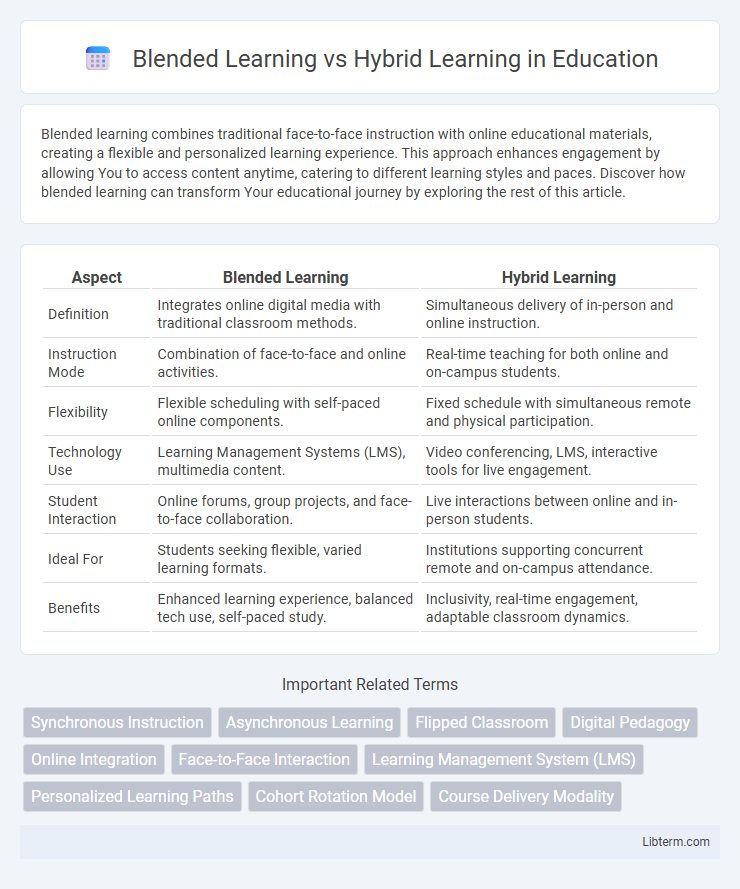Blended learning combines traditional face-to-face instruction with online educational materials, creating a flexible and personalized learning experience. This approach enhances engagement by allowing You to access content anytime, catering to different learning styles and paces. Discover how blended learning can transform Your educational journey by exploring the rest of this article.
Table of Comparison
| Aspect | Blended Learning | Hybrid Learning |
|---|---|---|
| Definition | Integrates online digital media with traditional classroom methods. | Simultaneous delivery of in-person and online instruction. |
| Instruction Mode | Combination of face-to-face and online activities. | Real-time teaching for both online and on-campus students. |
| Flexibility | Flexible scheduling with self-paced online components. | Fixed schedule with simultaneous remote and physical participation. |
| Technology Use | Learning Management Systems (LMS), multimedia content. | Video conferencing, LMS, interactive tools for live engagement. |
| Student Interaction | Online forums, group projects, and face-to-face collaboration. | Live interactions between online and in-person students. |
| Ideal For | Students seeking flexible, varied learning formats. | Institutions supporting concurrent remote and on-campus attendance. |
| Benefits | Enhanced learning experience, balanced tech use, self-paced study. | Inclusivity, real-time engagement, adaptable classroom dynamics. |
Understanding Blended Learning
Blended learning integrates traditional face-to-face instruction with online digital media, offering flexibility and personalized learning experiences. It emphasizes seamless interaction between in-person and virtual environments to enhance student engagement and retention. Key components include adaptive learning technologies, synchronous and asynchronous activities, and continuous assessment to optimize educational outcomes.
What Is Hybrid Learning?
Hybrid learning combines in-person classroom instruction with online learning activities, allowing students to engage flexibly in both environments. This approach integrates synchronous face-to-face sessions with asynchronous digital content, optimizing accessibility and personalized pacing. Educational institutions adopt hybrid learning to enhance student engagement, maximize resource utilization, and support diverse learning styles effectively.
Key Differences Between Blended and Hybrid Models
Blended learning integrates traditional face-to-face instruction with online activities within a single course, ensuring students experience a seamless mix of both formats. Hybrid learning divides the student cohort into separate groups, with some attending in-person sessions while others participate online simultaneously or on alternate days. The key difference lies in blended learning's unified instructional design versus hybrid learning's parallel delivery system catering to different student subsets.
Benefits of Blended Learning
Blended learning offers personalized education by combining traditional classroom instruction with online digital resources, enhancing student engagement and flexibility. This approach supports diverse learning styles and paces, resulting in improved retention and academic performance. Schools adopting blended learning benefit from cost efficiency and scalable access to high-quality educational content.
Advantages of Hybrid Learning
Hybrid learning combines in-person and online education, offering flexible access to diverse resources that enhance student engagement and accommodate different learning styles. It allows real-time interaction and immediate feedback during face-to-face sessions while leveraging digital tools for interactive and personalized learning experiences. Hybrid learning supports improved collaboration, greater resource accessibility, and the ability to balance synchronous and asynchronous instruction, resulting in higher retention and academic performance.
Challenges in Blended Learning Environments
Blended learning environments face challenges such as inconsistent student engagement, technological disparities, and difficulties in maintaining seamless integration between online and face-to-face components. Educators often struggle with balancing digital tools and traditional teaching methods, which can lead to fragmented learning experiences. Addressing issues like limited access to reliable internet and insufficient training for instructors is crucial to optimize blended learning efficacy.
Common Pitfalls in Hybrid Learning
Hybrid learning often faces common pitfalls such as inconsistent student engagement due to varying access to technology and differing learning environments. Technical issues and poor integration between in-person and online components can disrupt the learning flow and reduce educational effectiveness. Educators also struggle with balancing instructional methods, leading to challenges in maintaining cohesive course structure and student participation.
Choosing the Right Approach: Blended vs Hybrid
Choosing the right approach between blended learning and hybrid learning depends on the goals and resources of an educational program. Blended learning integrates face-to-face instruction with online components to create a unified experience, ideal for structured environments seeking flexibility without sacrificing in-person interaction. Hybrid learning splits students into separate groups attending either online or in-person sessions, offering adaptive scheduling but requiring careful coordination to maintain consistent engagement across modalities.
Real-World Examples of Blended and Hybrid Learning
Blended learning integrates in-person classroom instruction with online educational materials, exemplified by universities like Harvard, where students engage in face-to-face discussions alongside virtual modules. Hybrid learning combines synchronous online sessions with traditional face-to-face classes, as seen at Stanford University, allowing students to alternate between physical attendance and live virtual participation. Both models leverage technology to enhance flexibility and accessibility, catering to diverse student needs in various educational settings.
Future Trends in Education: Blended and Hybrid Learning
Blended learning integrates online digital media with traditional classroom methods, allowing flexible and personalized education pathways, while hybrid learning combines synchronous in-person and online sessions to enhance real-time interaction. Future trends emphasize increased use of AI-driven analytics and adaptive learning technologies to customize experiences and improve student outcomes in both models. Educational institutions are investing in scalable platforms and immersive tools, such as virtual reality and gamification, to create more engaging, accessible, and inclusive learning environments.
Blended Learning Infographic

 libterm.com
libterm.com